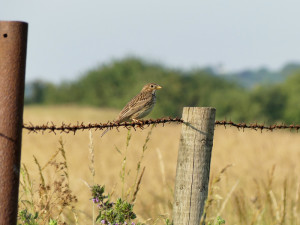
Today I spent most of my time analyzing the data I have collected observing Corn Bunting habitat selection. I initiated a study of Corn Buntings from May to August 2006 in order to record the crop selection of calling males in the study area and to attempt to make a map which would show all territories. I am currently in the third year of my degree, studying Wildlife and Countryside Conservation, and the data I have collected is to be discussed in my dissertation. I did all the fieldwork in East Yorkshire/North Lincolnshire and I am now writing up my findings and creating all the maps and graphs that are needed to illustrate them.
I surveyed in the region of 100 square kilometres near RSPB Blacktoft Sands and found 168 singing male Corn Buntings. I plotted their territories and recorded the crops that each was using, whilst mapping the land use of the entire area. Fortunately, the weather was really warm and sunny for most of the study period, so the task was very pleasant indeed.
The initial results show quite a preference for Winter Barley in the period from 15th May to 15th June, but this changed after this period. The Barley was harvested in the first few days of July and the implication is that most of the nests were destroyed by this. On the positive side, birds seemed to be making use of other crops after this, perhaps making another attempt to breed. Winter Wheat and Peas were both popular from mid June to mid July. The next stage is to work out a biodiversity value for each kilometre grid square and to compare that with Corn Bunting territory density, to see if there is an association between crop diversity and Corn Bunting density.
I also recorded Corn Bunting song posts, although this will not be a part of my dissertation as I already have quite enough data with the crop selection records. I recorded what the males were using as song posts, and the results were quite interesting (See graph below).

For anyone who can’t quite read the annotations on the graph I will outline what the three obviously favoured song posts are:
The first tall column from the origin is for umbellifers; both Cow Parsley, Hogweed etc.
The second tall column, which reaches to about 50, is for trees and large bushes.
The last tall column is for overhead wires.
All the other columns are for various arable weeds and crops and it is quite clear from this graph that, even before running statistical tests, all of these other song post selections are not significant compared to the three highly selected types.
Most birdwatchers that have seen Corn Buntings will have noticed birds using wires and trees to call from, but the massive preference for umbellifers over other arable weeds has been of interest to most people I have spoken to, including several people involved in Corn Bunting conservation.
There will be plenty more about Corn Buntings here when I’ve done further work with my data, I’ll have to get a move on, my dissertation has to be in by mid April; almost a year after doing the work!


 January 15th, 2007
January 15th, 2007  Nick
Nick  Posted in
Posted in  Tags:
Tags: 










